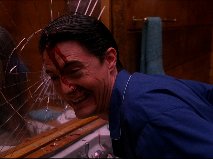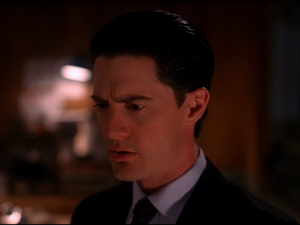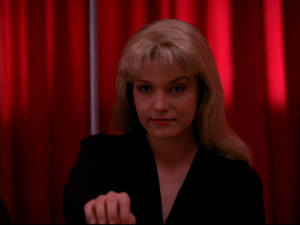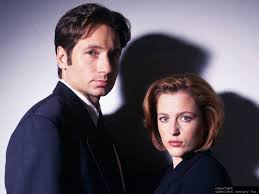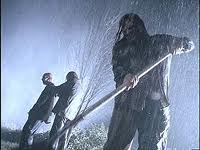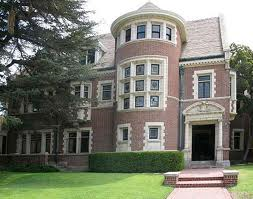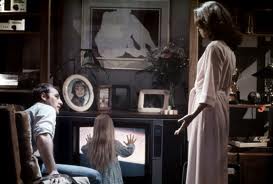Posted by Sarah
After running the session on Twin Peaks and The X Files, Frances has very kindly provided the following summary of our discussion.
In this week’s session the discussion focused mainly on the relationship between Twin Peaks and The X-Files as popular television shows and the use of horror and melodrama as predominant features throughout both. Continuing the discussion points raised by the previous session’s screening of American Horror Story, it was commented upon again this week how the serial format of television allows greater opportunity to develop this connection between horror and melodrama, particularly in respect to the viewers’ relationship with the characters of the shows. Twin Peaks is a good example of this as it is a series which features a big ensemble cast and many sub-plots interweaving with the main narrative: the mystery surrounding Laura Palmer’s death.
The clip from Twin Peaks: Fire Walk With Me demonstrates this well as the sequence moves from the portrayal of Laura as a popular albeit troubled high school girl to much darker events which show Laura as the victim of evil forces (human and possibly supernatural) in her own home. The shots focusing on the house’s staircase, Laura’s bedroom door and the strange events which take place during Laura’s dream (her doubling in the picture) are particularly striking and correlate to common Gothic tropes. Twin Peaks’s combination of melodrama, thriller and horror makes it a good example of Gothic Television as outlined in Ledwon’s article, which we found useful. Ledwon’s article does raise the question: what would be a contemporary example of Gothic Television? In this session we did also talk about recent rumours that Twin Peaks may be brought back or re-booted and we agreed that this would probably would not work or be as successful: the series seems very much of ‘its time’.
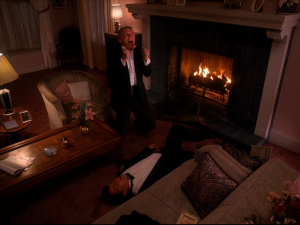 We also discussed performance and melodrama in Twin Peaks and how the acting is, at times, quite ‘hammy’. A good example of this is the sequence where Doctor Hayward comes home to discover Ben Horne in his family home, the latter having revealed that he is the biological father to Hayward’s daughter Donna. Donna is distraught at the news and Hayward is enraged at the upset Horne has brought upon his family and so hits him, causing Horne to fall onto the fireplace and receive a severe – and possibly fatal – injury to the head. The scene ends with Donna and her mother crying, Horne unconscious on the floor and Hayward falls to his knees and cries out, shaking his fists in the air.
We also discussed performance and melodrama in Twin Peaks and how the acting is, at times, quite ‘hammy’. A good example of this is the sequence where Doctor Hayward comes home to discover Ben Horne in his family home, the latter having revealed that he is the biological father to Hayward’s daughter Donna. Donna is distraught at the news and Hayward is enraged at the upset Horne has brought upon his family and so hits him, causing Horne to fall onto the fireplace and receive a severe – and possibly fatal – injury to the head. The scene ends with Donna and her mother crying, Horne unconscious on the floor and Hayward falls to his knees and cries out, shaking his fists in the air.
The scene is representative of the kind of melodrama used in Twin Peaks which usually takes place in the private space of the family home and involves the revelation of devastating secrets. Another example of this is the scene where Nadine Hurley regains her memory (after believing for a long period that she was a high school teenager following her suicide attempt) and finds that her husband Ed is in a relationship again with an old lover, Norma. This scene, like the one in the Hayward home, is left unresolved. We discussed how this is can leave viewers frustrated by the lack of a definitive conclusion – a comment which can be extended to the show’s finale in general – but also in relation to the fact that often the good characters in Twin Peaks also suffer. Doctor Hayward, in particular, is a ‘nice guy’ but is not exempted from the consequences of the show’s many family melodramas.
 We spoke at great length about The X-Files episode we watched called Home. The use of music stood out in this episode, particularly during the Peacock brothers’ attack on the sheriff and his wife. The juxtaposition of such upbeat music with the gruesome and disturbing imagery reminded us of Lynch’s work, particularly Blue Velvet. Home also compares quite well to Twin Peaks as both shows portray the American Dream through the representation of small-town America with a particular emphasis on the family. The crimes which are committed in secret in both these towns are exposed by the intruding FBI agents, although the local law enforcers support the government agency’s work. The sheriff in Home is given particular emphasis as he explicitly states how he loves the town as it is – with habitants leading apparently simple and honest lives – and he does not want the grizzly crime discovered at the episode’s opening or the presence of Mulder and Scully to change that. In this way the episode sets up a number of conventional binaries: small town versus the city; the crimeless rural versus the corrupt city; the traditional nuclear family versus the domination of isolating careers for agents in the FBI. With the character of the sheriff, the episode begins by following this conventional path, emphasising the richness of possibilities such an American Dream can have.
We spoke at great length about The X-Files episode we watched called Home. The use of music stood out in this episode, particularly during the Peacock brothers’ attack on the sheriff and his wife. The juxtaposition of such upbeat music with the gruesome and disturbing imagery reminded us of Lynch’s work, particularly Blue Velvet. Home also compares quite well to Twin Peaks as both shows portray the American Dream through the representation of small-town America with a particular emphasis on the family. The crimes which are committed in secret in both these towns are exposed by the intruding FBI agents, although the local law enforcers support the government agency’s work. The sheriff in Home is given particular emphasis as he explicitly states how he loves the town as it is – with habitants leading apparently simple and honest lives – and he does not want the grizzly crime discovered at the episode’s opening or the presence of Mulder and Scully to change that. In this way the episode sets up a number of conventional binaries: small town versus the city; the crimeless rural versus the corrupt city; the traditional nuclear family versus the domination of isolating careers for agents in the FBI. With the character of the sheriff, the episode begins by following this conventional path, emphasising the richness of possibilities such an American Dream can have.
H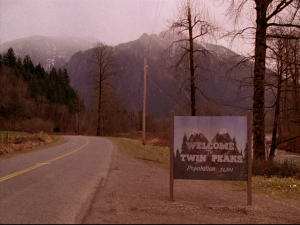 owever the presence of the Peacock family in the narrative very quickly subverts this and, as with the Laura Palmer investigation in Twin Peaks, The X-Files also exposes this dream to be just an illusion and that evil lurks within this small town too. Home presents this subversion in two main ways. First, in contrast to Twin Peaks, Home does not deny that loving families exist: the controversy of the episode is that this loving ‘family’ commits the ultimate taboo – incest. The Peacock family have been reproducing via this practice for several generations and this has led to numerous mental and physical degenerations, which is visibly marked on the brothers’ faces. Their appearance in the show opens the episode and – even before we learn the reasons for their physical deformities – the brothers are portrayed as monsters. The music, the use of heavy shadow and the storm which accompanies their introduction quickly establishes the Peacock brothers as the enemy to be investigated, particularly as the show opens with a disturbing birthing scene which concludes with the siblings burying the offspring in the garden.
owever the presence of the Peacock family in the narrative very quickly subverts this and, as with the Laura Palmer investigation in Twin Peaks, The X-Files also exposes this dream to be just an illusion and that evil lurks within this small town too. Home presents this subversion in two main ways. First, in contrast to Twin Peaks, Home does not deny that loving families exist: the controversy of the episode is that this loving ‘family’ commits the ultimate taboo – incest. The Peacock family have been reproducing via this practice for several generations and this has led to numerous mental and physical degenerations, which is visibly marked on the brothers’ faces. Their appearance in the show opens the episode and – even before we learn the reasons for their physical deformities – the brothers are portrayed as monsters. The music, the use of heavy shadow and the storm which accompanies their introduction quickly establishes the Peacock brothers as the enemy to be investigated, particularly as the show opens with a disturbing birthing scene which concludes with the siblings burying the offspring in the garden.
We discussed how, in this way, Home addresses two fears: the taboo of inbreeding and the Hollywood’s obsession with the aesthetics of bodies, especially the idea of being ‘body perfect’. The Peacock family not only tackles both these issues head-on, but they subvert expectations by finding this family life ‘normal’. Indeed, the melodramatic moments of family drama in the episode occur because the Peacocks are attempting to protect their way of life from intruders. Contrary to the expectations evoked by the show’s provocative opening, the Peacocks are the ‘small town’ community which are being invaded by the judgement and investigation of others. This interpretation of events on behalf of the Peacock family is reinforced by the fact it is FBI agents – Mulder and Scully – who instigate this intrusion and who, literally, invade the family’s home. The sharp contrast between the 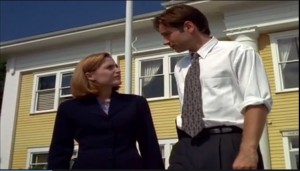 obvious love and loyalty expressed by the Peacocks against their out-of-town counterparts is emphasised in this episode as Mulder and Scully are shown at times to be dysfunctional themselves, and it is stressed how Scully cannot empathise with Mrs Peacock as she has never been a mother.
obvious love and loyalty expressed by the Peacocks against their out-of-town counterparts is emphasised in this episode as Mulder and Scully are shown at times to be dysfunctional themselves, and it is stressed how Scully cannot empathise with Mrs Peacock as she has never been a mother.
The second way the show subverts expectations – and the components of the so-called American Dream – is with the way it portrays who is at fault in the episode. Certainly the Peacock family is represented as monstrous; a disturbing corruption of what a family should look like. But an important part of the horror in the show stems from the way the other townspeople have chosen to ignore the repulsive family and their lifestyle in order to maintain the town’s respectability. The sheriff encompasses this attitude: he is eager to find out who murdered the baby found at the beginning but wants to do so in order to return life to the way it was. His unwillingness to investigate the Peacocks – even when it is clear that they must be an important part of the investigation – makes him just as culpable in the crime. We discussed how the horror therefore comes from within: from attempting to keep life the same in the town and ignoring perversions in favour of an illusion of stability and normality. It was commented how this is a very Lynchian trope and peculiarly American.
Extending this last point further, Home also explores similar themes found in horror films which engage with an imagined geography of America, where the small and rural town is threatening in its own way. Like The Texas Chainsaw Massacre and The Hills Have Eyes, Home taps into the fear that living in isolation is not only possible but can be the catalyst for the horrific events which takes place in such narratives. The believability that such family like the Peacocks could exist in America is a particularly potent element of this fear. As such the science-fiction label given to The X-Files does not seem entirely suitable. This episode, like many others in the series, does not create horror and melodrama from supernatural or paranormal activities. In this respect we found the Bellon article useful in critiquing the classification of The X-Files as a science fiction, although the use of ‘ontological detective story’ was not found to be entirely satisfactory as an alternative genre either. We agreed that melodrama, thriller and horror are important genres informing the show’s narrative, performance and visual style. This link is strengthened by comparing Home to previous screenings and we found similar themes of holding onto the past, wanting to keep life the same and living in isolation in Whatever Happened to Baby Jane?.
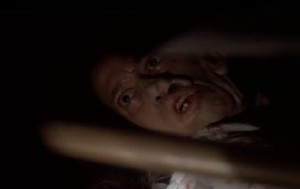 Finally Home also presents the viewer with complex representations of gender. When watching the first half of the episode, we think Home is presenting us with traditional ideas of gender: we, like Mulder and Scully, believe at first that the Peacock brothers have kidnapped a woman to reproduce with. Scully comments that the basic instinct to reproduce may be motivating the brothers and Mulder later calls the Peacock’s reaction to their scrutiny as demonstrating raw, animalistic behaviour. The woman-as-mother motif is raised continuously throughout the episode, beginning with the labour scene and the suspicion the brothers have kidnapped a woman, and then again when Scully talks about her own desires for a family. This notion of women is embodied by the
Finally Home also presents the viewer with complex representations of gender. When watching the first half of the episode, we think Home is presenting us with traditional ideas of gender: we, like Mulder and Scully, believe at first that the Peacock brothers have kidnapped a woman to reproduce with. Scully comments that the basic instinct to reproduce may be motivating the brothers and Mulder later calls the Peacock’s reaction to their scrutiny as demonstrating raw, animalistic behaviour. The woman-as-mother motif is raised continuously throughout the episode, beginning with the labour scene and the suspicion the brothers have kidnapped a woman, and then again when Scully talks about her own desires for a family. This notion of women is embodied by the
mystery woman in the Peacock house who is revealed to be the brothers’ mother. Mrs Peacock states that Scully (and by extension other women) cannot understand the love she has for her family despite their murderous act because she is not a mother. Mrs Peacock is a form of the monstrous feminine, as postulated by Barbara Creed: she is the source of all life and this is her sole purpose for living. Without any limbs and restrained on a board beneath the bed, Mrs Peacock is a ‘baby machine’, reducing her femininity to the core components necessary for reproduction.
This confinement to the woman-as-mother is emphasised by the episode’s opening, which introduces viewers immediately to the disturbing labour scene. The repeated shot of Mrs Peacock’s eyes – both in this opening and repeated again when Mulder and Scully visit the empty house and then finally when they find the mother under the bed – is very effective as it still gives a human and expressive face to an otherwise biological ‘machine’. Opening the show with Mrs Peacock giving birth also compares to the opening of American Horror Story and Vivian’s gynaecologist appointment. The emphasis of women’s bodies as a ‘house’ in American Horror Story is extended in The X-Files where ‘home’ takes on several meanings: it is the episode’s title; it refers to the creepy Peacock house; and it also references the family Mrs Peacock attempts to maintain, with her body as the means for creating new life. The episode’s ending, where Mrs Peacock escapes with one of her sons, suggests that the Peacocks shall continue in their quest for creating this home.
Mrs Peacock’s agency in this concluding sequence is where the representation of woman-as-mother is complicated. Mrs Peacock is not made into an archaic mother endlessly producing new offspring against her will: she willingly and enthusiastically accepts this role and she is revealed to be the matriarch of the family, the brothers following her commands. Once again the episode inverts expectations. Mrs Peacock does not see herself as monstrous, nor does she need or want to be saved. This revelation taps into and stresses the fears explored earlier and is an important part of the show’s horrifying impact.
As a concluding point, we also noted how the manner in which television shows are watched has changed considerably since the 1990s. Twin Peaks and The X-Files would have both been consumed on a weekly basis. Today, whilst this broadcasting practice still exists, many viewers also watch the shows in box-sets or streamed from online services, with the option to watch many or all the episodes at once. The difference this may make to the narratives of such shows – and particularly how melodrama is used to keep the viewer’s interest – is still an area to be explored.
Many thanks to Frances for choosing such interesting TV episodes and for the great summary!
Do, as ever, log in to comment, or email me on sp458@kent.ac.uk to add your thoughts.

